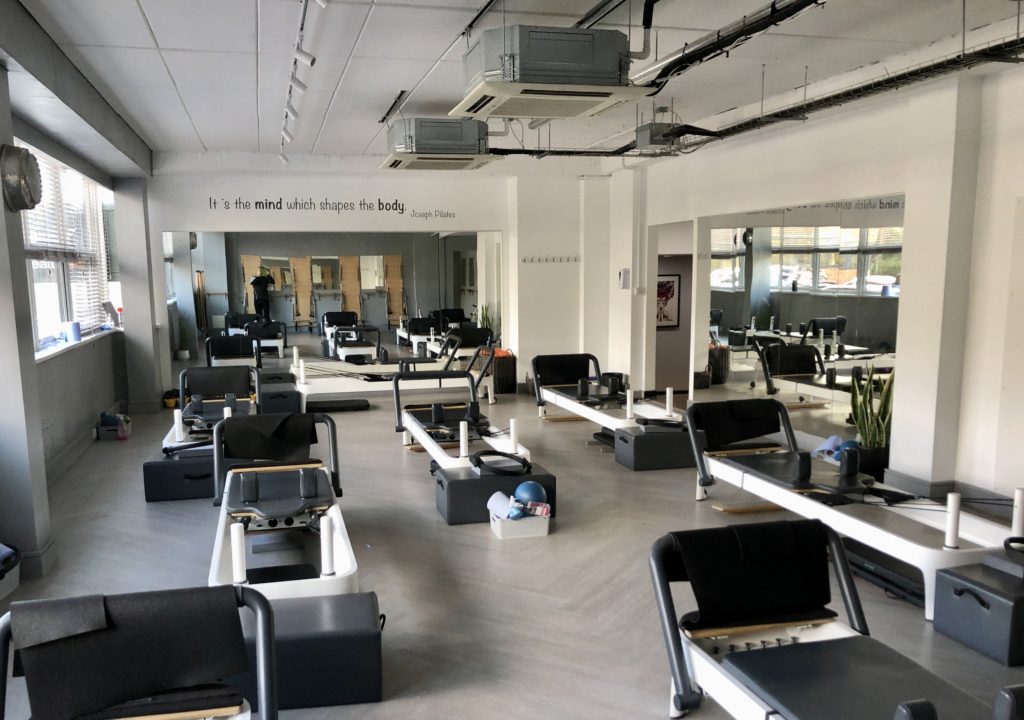Dynamic Reformer Pilates?
Take this quick Pilates quiz...
Q1. Do you do Mat Pilates? 🤔
Q2. Do you do Reformer Pilates? 🤔
Q3. Do you do “Dynamic Reformer Pilates”? 🤔
❓ Even if you answered “yes” to two or more of the above questions, you still might not actually be doing Pilates…
We often get asked if we teach “Reformer Pilates” in the next breath many people say that they want to do Reformer Pilates, not Mat Pilates. “Reformer Pilates” has become a buzzword, and bow we have “Dynamic Reformer Pilates”.
In actual fact, they aren’t two distinct things What you learn on the Reformer helps you with your Mat and it’s also true the other way around…
But doin just one and leaving out the other is like eating just a slice of the pie and leaving the rest behind!
Related Post: Why are there so many variants and varieties of Pilates?
Click here to find out more about the Pilates lawsuit.
Fitness is big business, and so is marketing
Matwork is "out" because Reformer Pilates is "in"...
... and now, the "new" new is Dynamic Reformer Pilates!
There’s been all kinds and variants of Pilates: Mat Pilates, Reformer Pilates, Cardio Pilates, HIIT Pilates, Athletic Pilates, Yogalates, Piloxing, Megaformer, Physio Pilates, Rehab Pilates, Clinical Pilates…
And now there’s a new type of Pilates to add to them: “Dynamic Reformer Pilates”. I’ve taken classes and I can tell you all about it!
But, first things first, it may surprise you to know that there isn’t such a thing as “Reformer Pilates”. That’s not just an opinion, it is a fact.
Neither Reformer, nor Mat, are not types of Pilates. It’s not like there was once “Mat Pilates” or even “Floor Pilates” and now you should be doing “Reformer Pilates”. And now that “Dynamic Reformer Pilates” is ehre, we should all be doing that now.
It’s marketed as a “new thing” and because it’s new, it’s better than Reformer Pilates and Mat Pilates before that …
The “newness” Myth is busted: – the first Reformer Patent dates from 1927.
The 1927 Reformer Patent:

That’s marketeers doing their work – and they do it VERY well. But it’s still not Pilates.
“Dynamic Pilates” is a phrase coined by the marketing departments for fitness companies.
It suggests that Matwork Pilates is dull and slow and boring but has suddenly got more exciting and dynamic and now we should all be doing it on the Reformer instead. Just like all the celebs.
If "dynamic" Reformer is the new in thing, then Mat Pilates must be so dull and so "yester-year"...
... is the implied message.
It’s worth repeating: Dynamic Pilates (whether on Mat or Reformer) is a very clever marketing buzzword. It implies that the Matwork is dull, static and boring.
But is anything but! In fact it’s difficult to imagine anything more dynamic than Pilates whether on Reformer or Mat. You’d be approaching gymnastics to get more dynamic!
There are 34 (plus a few extra exercises) and it takes 20 minutes to do! That’s just over 35 seconds for each exercise (doing the full number of repetitions) and there’s no stopping between!
And there are no springs to assist you like on a Reformer!
Dynamic Pilates has proved to be
...more static than regular Pilates' Contrology
I’ve been to several Dynamic Reformer Pilates Classes. Without exception, each one was actually at a slower pace than Pilates.
Not only that, but there were FAR more repetitions (40 instead of say 6 for Frogs and Leg Circles) for each exercise.
That means your moving slower and, and doing far fewer exercises due to the higher number of repetitions.
Finally, there were gaps between the exercises for “a rest” or for “stretching”.
Pilates has none of those things. Regular Pilates (let’s call it Contrology?) is far more dynamic than Dynamic Reformer Pilates.
The majority of the exercises were not Pilates at all.
Joseph Pilates teaching his method. It's dynamic!
... but there are different types of Pilates, aren't there?
There was only one Joseph Pilates – and he created Contrology, now called “Pilates”. He died in 1967. What is now call “Pilates” is the interconnected system of exercises that he created.
If you change it a little, it becomes diluted. If you change it a lot, it just isn’t Pilates anymore.
A super milky latte… is it a coffee or milk drink?
Now that "Dynamic Reformer" is here,
... "Reformer Pilates" is yesterday's news
Encouraged by fitness companies, many Personal Trainers go out to get “instant training” on Reformer – or often it’s in-house.
These same fitness companies introduce Reformers into gyms – and definitely enjoy commercial success – I know because I’ve been to these classes… It’s big business.

Yes, it’s big business. Each of those Reformers cost upwards of £4000!
And the Fitness Gym Owners are the ones in charge. The instructors are only paid £12 – £20 an hour. On that salary, how can a fitness instructor pay £6000+ for proper Comprehensive Pilates Teacher Training?
The implication from the marketing is that you should be feeling the burn of the lunge or squat combo after 45 continuous repetitions so that you get that ultimate bootcamp workout! And you do feel a burn because you’re doing so many repetitions! But you can’t concentrate fully: the mind goes to sleep! It is Anti-Contrology – the opposite of what Pilates is supposed to be.
That is “Anti-Contrology” – Contrology is the original name for Joseph Pilates’ Method of Exercise.

Pilates isn't just exercise...
It's an integrated method of mind, body & spirit development
There is Exercise. There is Pilates. But Pilates isn’t just exercise. Find out the Mind, Body Spirit elements of Pilates: click here.
You can’t take generic fitness exercises, plonk them on a Reformer and call it Pilates.
Pilates includes working out on a Reformer. And it always has since it was first patented in 1927. So, it’s not a new fad….
“I stopped going to group “Reformer Pilates” classes after I realised the people classes (up to 12 people) were so generic and ‘one size fits all’. The instructors were ‘ gym instructors’ not Pilates teachers. Pilates was a side hustle for them rather than a profession. We didn’t learn Pilates and develop & progress. Instead, we were led through lesson plans that the instructors planned for everyone to do. Sometimes it was headstands on a reformer, sometimes it was lunges and squats, sometimes to feel the burn, sometimes the Hundred but not till the end which I now know is not the Reformer order. We had to bow and say "namaste" at the end, which know definitely has no place in Pilates. It was just a mish mash of so many different things that it wasn't anything anymore. I didn’t feel very unique, it felt like a conveyor belt!”
Anayah Melia
Joe Pilates said his method was a system and a discipline. He’s right! There is a structure. You develop discipline to:
- learn the exercises – he even calls them “multiplication tables”;
- learn appropriate modifications for your body;
- learn that it’s about progressing and evolving into more complex movements;
- be patient with your progress;
- learn layers of quality, not repetitions;
- work the full studio apparatus;
- know what springs you need;
- know if you need a sticky mat;
- know if a long or short box needed, straps, extensions?
… and everyone travels along that journey at different speeds and in different ways…or not at all
Things to watch for…
Here are some things that you can ask yourself to discover if what you are doing IS in fact Pilates:
❓ Do you know what the first exercise is?
❓ Do you know how to get to the next one?
❓ Could you take yourself through a workout or set up the basics.
❓ Do you know what Reformer exercise aren’t great for your bad back, neck issue, osteoporosis, hip replacement?
❓ Does your Reformer class change constantly or do you stick to learning the order?
❓ Is your teacher Pilates fully comprehensively trained on all apparatus or trained to teach on the Reformer?
We want you get the whole of the pie!
So…. To help YOU learn how to do Pilates in the basic exercises WITH the Reformer, and not just ON a Reformer, we have One on One First Lesson and up to 12 One on One Starter Lessons that will introduce you to the full Pilates system (part of it is the Reformer).
If you liked this information, and would like to learn more, why not book a “First Lesson”?
















